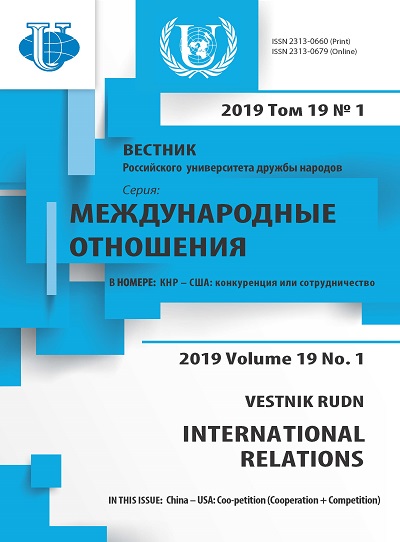US-China Economic Confrontation: Ideology, Chronology, Meaning
- Authors: Vinogradov A.O.1, Salitsky A.I.2, Semenova N.K.3
-
Affiliations:
- National Research University Higher School of Economics
- Primakov National Research Institute of World Economy and International Relation of the Russian Academy of Sciences
- Institute of Oriental Studies of the Russian Academy of Sciences
- Issue: Vol 19, No 1 (2019): China — USA: Coo-petition (Cooperation + Competition)
- Pages: 35-46
- Section: THEMATIC DOSSIER
- URL: https://journals.rudn.ru/international-relations/article/view/20850
- DOI: https://doi.org/10.22363/2313-0660-2019-19-1-35-46
Cite item
Full Text
Abstract
In summer 2018 the United States launched a trade war against China. Before that, there was a chance that both sides would find a compromise, some hopes were still in place during bilaterial negotiations in May. However, new US tariffs on import from China were imposed in July and August with the total of $50 billion. Beijing responded proportionally. September brought another round of US tariffs worth $200 billion. The successful economic growth of China leads to the transformation of the world economic space, where the leading positions are still occupied by the countries of the West. The new US administration, fearing economic competition, announced a policy of containing China. In this case, Washington is going to violate the existing rules of international trade. The tension in the economic relations of the United States and China is growing. The authors look into the history, ideology and details of the conflict between two major powerhouses of the global economy. They try to investigate how both countries will be affected by the emerging trade war, which is also challenging the whole system of international trade regulation. Besides, the conflict between Washington and Beijing is understood as a fundamental shift in the world economy and politics where rising powers take the lead in globalization. For the first time in the history of Sino-American relations economic tensions between the two sides have reached such a scale. Analysis of their consequences far exceeds the standard methods of assessment of trade policy measures.
Keywords
About the authors
Andrei Olegovich Vinogradov
National Research University Higher School of Economics
Author for correspondence.
Email: vinandr@mail.ru
PhD in Historical Sciences, Senior Lecturer, School of Asian Studies, National Research University Higher School of Economics, Leading Researcher of the Center for the Study and Forecasting of Russian-Chinese Relations of the Institute of Far Eastern Studies, Russian Academy of Sciences
Alexander Igorevich Salitsky
Primakov National Research Institute of World Economy and International Relation of the Russian Academy of Sciences
Email: sal.55@mail.ru
Doctor of Economic Sciences, Chief Researcher of the Center for Development and Modernization Problems of the Primakov National Research Institute of World Economy and International Relation, Russian Academy of Sciences
Nelli Kimovna Semenova
Institute of Oriental Studies of the Russian Academy of Sciences
Email: semenovanelli-2011@mail.ru
PhD in Political Science, Senior Research Associate of the Economic Research Department of the Institute of Oriental Studies, Russian Academy of Sciences
References
- Banning, G. (2010). Sino-American Relations in the Era of Globalization — A Framework for Analysis. Procedia — Social and Behavioral Sciences, 2 (5), 7249—7267. URL: https://www.sciencedirect.com/science/article/pii/S1877042810012140 (accessed: 03.11.2018).
- Bond, P. (2016). BRICS banking and the debate over sub-imperialism. Third World Quarterly, 37 (4), 611—629. DOI: https://doi.org/10.1080/01436597.2015.1128816.
- Godement, F. & Vasselier, A. (2017). China at the Gates: a New Power Audit of EU—China Relations. London: The European Council on Foreign Relations (ECFR). URL: http://www.ecfr.eu/publications/summary/china_eu_power_audit7242 (accessed: 22.10.2018).
- Huan, Xiang (1981). On Sino-U.S. Relations. Foreign Affairs. URL: https://www.foreignaffairs.com/articles/china/198109-01/sino-us-relations (accessed: 26.09.2018).
- Studwell, J. (2013). How Asia Works: Success and Failure in the World's Most Dynamic Region. London: Profile books.
- Kissinger, H. (2011). On China. New York: Penguin Press.
- Kondrashova, L.I. (2018). American Scientists and Politicians on the Economic Strategy of China. Asia and Africa Today, 2 (727), 16—22. (In Russian).
- Mytareva, E.A. (2009). The role of «trade wars» in the global economy. In: World economy and society: from crisis to crisis. Part 2. Saratov: Science, p. 254—255. (In Russian).
- Navarro, P. & Autry, G. (2017). Death by China: Confronting the Dragon — A Global Call to Action. Moscow: Sinosphere. (In Russian).
- Navarro, P. (2007) The Coming China Wars. Where They Will Be Fought and How They Can Be Won. Moscow: Vershina. (In Russian).
- Pillsbury, M. (2015). The Hundred Year Marathon: China’s Secret Strategy to Replace America as the Global Superpower. New York: St. Martin Griffin.
- Spence, M. (2011). The Next Convergence: The Future of Economic Growth in a Multispeed World. N.Y.: Farrar Straus Giroux.
- Salitskii, A.I. (2018). The Outward Expansion of China As a Result of Its Victorious Modernization. Herald of the Russian Academy of Sciences, 88 (1), 104—110.
- Safonkina, E.A. (2018). Chinese 2017 BRICS Presidency: expanding cooperation horizons. Vestnik RUDN. International Relations, 18 (2), 356—367. doi: 10.22363/2313-0660-2018-18-2-356-367. (In Russian).
- Schlesinger Jr., A.M. (1992). The Cycles of American History. Moscow: Progress-Academy. (In Russian).
- Stephen, J.R. (2018) Is Foreign Trade the Cause of Manufacturing Job Losses? Urban Institute. URL: https://www.urban.org/ sites/default/files/publication/97781/is_foreign_trade_the_cause_of_manufacturing_job_losses_2.pdf (accessed: 15.11.2018).
- Varfalovskaya, R.A. (2018). The development of China’s foreign trade in the context of globalization and «trade wars» of the USA. The Far Eastern Affairs, 6, 85—91. (In Russian).
- Vinogradov, A.O. & Salitsky, A.I. (2018). US—China: Trade War Unleashed. URL: http://www.perspektivy.info/ oykumena/ekdom/ssha kitaj_torgovaja_vojna_razvazana_2018-08-13.htm (accessed: 07.09.2018). (In Russian).











